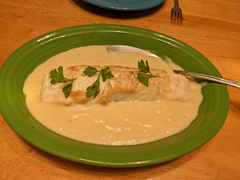 If you have made the Fillets of Sole Bercy, then this richer, more elegant Parisian version will be easy. It's essentially the same recipe but the sauce gets a little more attention, including thickening it with egg yolks.
If you have made the Fillets of Sole Bercy, then this richer, more elegant Parisian version will be easy. It's essentially the same recipe but the sauce gets a little more attention, including thickening it with egg yolks.
After you make a Sauce Parisienne, you can garnish it in various ways to make it Normande, Dieppoise, Nantua, Bonne Femme, etc.
I made this one with halibut, but any white fish will work.

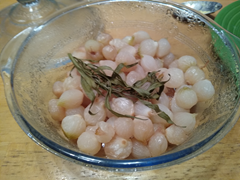 This is a delicious side dish to accompany roast chicken or pork. I use the frozen pearl onions, the plain kind with no sauce, because this is so easy that it can be part of a dinner after a hard day.
This is a delicious side dish to accompany roast chicken or pork. I use the frozen pearl onions, the plain kind with no sauce, because this is so easy that it can be part of a dinner after a hard day.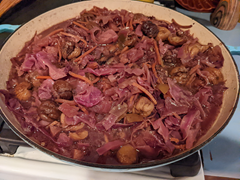 This Chou Rouge a la Limousine is a wonderful hearty fall-and-winter recipe to accompany roast pork or pork sausages, or roast goose. It's one of my favorite things to prepare when the cold weather finally returns to Plymouth!
This Chou Rouge a la Limousine is a wonderful hearty fall-and-winter recipe to accompany roast pork or pork sausages, or roast goose. It's one of my favorite things to prepare when the cold weather finally returns to Plymouth!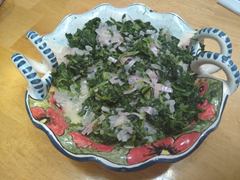 Here's a delightful side dish that can accompany many northern dishes (that is, dishes of the northern butter clan as opposed to the southern olive oil clan). It can be made with fresh or frozen spinach, so it's a handy recipe for when you have surprise dinner guests.
Here's a delightful side dish that can accompany many northern dishes (that is, dishes of the northern butter clan as opposed to the southern olive oil clan). It can be made with fresh or frozen spinach, so it's a handy recipe for when you have surprise dinner guests.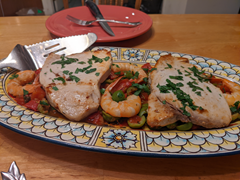 This is from the French Riviera, with the typical bright flavors of sunny Provence, but less complicated than the similar Sicilian
This is from the French Riviera, with the typical bright flavors of sunny Provence, but less complicated than the similar Sicilian 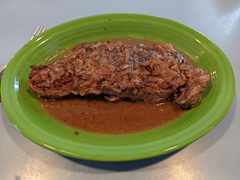 Steak au Poivre is awesome and awful - you really need to know what you are signing up for.
Steak au Poivre is awesome and awful - you really need to know what you are signing up for.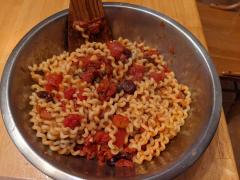 This feisty Sicilian (is that redundant?) recipe was inspired by the feisty protagonist in the classic opera Cavalleria Rusticana. Here I made it with the corkscrew pasta fusilli because it seemed to fit the theme, and because the long pasta works well with this chunky sauce.
This feisty Sicilian (is that redundant?) recipe was inspired by the feisty protagonist in the classic opera Cavalleria Rusticana. Here I made it with the corkscrew pasta fusilli because it seemed to fit the theme, and because the long pasta works well with this chunky sauce. This simple dish serves as the base for any number of derivatives to accompany all sorts of dinners. It easy to make with the frozen petite peas from the supermarket even in the dead of winter.
This simple dish serves as the base for any number of derivatives to accompany all sorts of dinners. It easy to make with the frozen petite peas from the supermarket even in the dead of winter. Ployes are a sort of buckwheat pancake from New Brunswick, Quebec, and Aroostook County, Maine. They are traditionally served at any time of day with any sort of topping. I show a couple here with apple butter, which was great with coffee for a light breakfast, but I've read about ployes topped with berries and cream, creamed fish, beef stew, and plain butter.
Ployes are a sort of buckwheat pancake from New Brunswick, Quebec, and Aroostook County, Maine. They are traditionally served at any time of day with any sort of topping. I show a couple here with apple butter, which was great with coffee for a light breakfast, but I've read about ployes topped with berries and cream, creamed fish, beef stew, and plain butter. Here's another old Plymouth dish made with fresh local
Here's another old Plymouth dish made with fresh local  This is another old Plymouth favorite. There's a Clam Pudding Pond in Plymouth, and one of my friends lives on Clam Pudding Road!
This is another old Plymouth favorite. There's a Clam Pudding Pond in Plymouth, and one of my friends lives on Clam Pudding Road!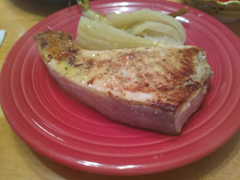 The traditional
The traditional  It took an awfully long time for me to find a recipe for a calve's liver dish that I liked. As was the case with many of us, my mom made it from time to time, a big slab of strange-looking, strange-smelling, strangely-textured strangeness that nobody wanted to eat. But this one I liked a lot, and I and my friend Andy both took additional helpings.
It took an awfully long time for me to find a recipe for a calve's liver dish that I liked. As was the case with many of us, my mom made it from time to time, a big slab of strange-looking, strange-smelling, strangely-textured strangeness that nobody wanted to eat. But this one I liked a lot, and I and my friend Andy both took additional helpings.  I decided a long time ago that I did not trust liver from cattle raised on factory farms fed who knows what feed and drugs, because all of that ultimately is processed by the liver. I found some Caldwell Farms calf liver at the Belfast Coop in Belfast, Maine. I knew it was going to be as good a piece of liver as I am likely to find, so I bought it for this recipe.
I decided a long time ago that I did not trust liver from cattle raised on factory farms fed who knows what feed and drugs, because all of that ultimately is processed by the liver. I found some Caldwell Farms calf liver at the Belfast Coop in Belfast, Maine. I knew it was going to be as good a piece of liver as I am likely to find, so I bought it for this recipe.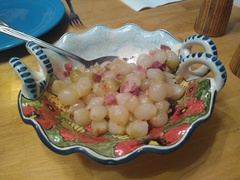 This is another fine, simple Italian recipe using pearl onions. Supermarket frozen onions work fine in this recipe, and they save a ton of time and sore thumbs from peeling.
This is another fine, simple Italian recipe using pearl onions. Supermarket frozen onions work fine in this recipe, and they save a ton of time and sore thumbs from peeling.